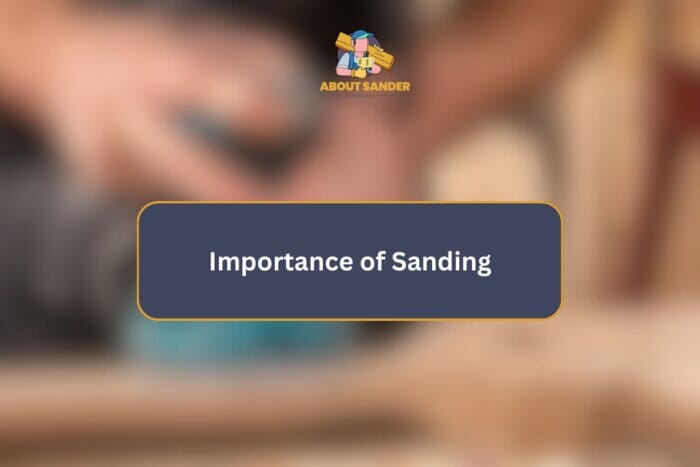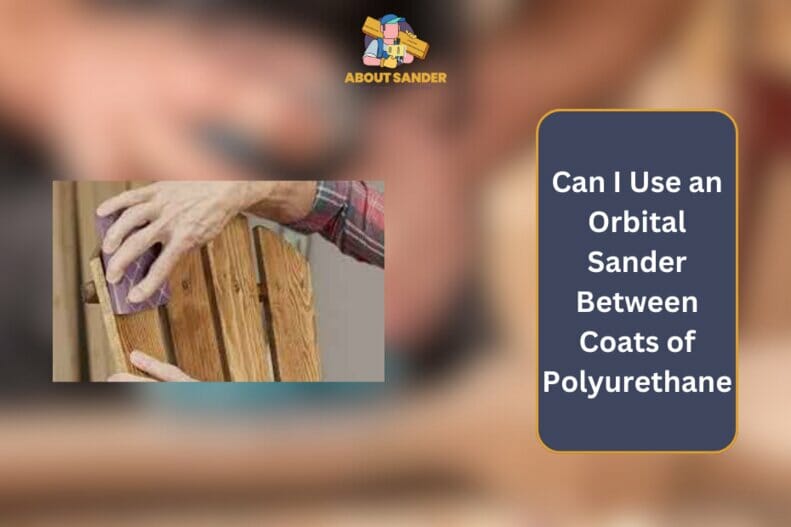Are you working on a project that requires applying multiple coats of polyurethane? The good news is, with the right approach, an orbital sander can be a helpful tool to achieve a smooth, even finish.
In this article, we’ll explore the ins and outs of using an orbital sander between coats of polyurethane. So, let’s dive in and answer the question: can I use an orbital sander between coats of polyurethane?
Key Takeaways:


- Sanding polyurethane between coats is important to achieve a smooth and even finish.
- Using an orbital sander is the most efficient way to sand between coats of polyurethane.
- It is recommended to use a fine grit sandpaper, such as 220 or 320 grit, to avoid damaging the previous coat of polyurethane.
- Sanding between coats of polyurethane helps to improve adhesion, remove any imperfections, and create a smooth surface for the next coat.
- It is important to wear appropriate safety gear, such as a dust mask and safety goggles, when sanding between coats of polyurethane.
- Careful consideration should be given to the temperature, humidity, and ventilation in the workspace to ensure the best results and avoid any safety hazards.
Here is the confusion “Can I use an orbital sander between coats of Polyurethane?”
Yes, you can use an orbital sander between coats of polyurethane, but it requires caution and careful consideration. Use fine-grit sandpaper and sand lightly to avoid sanding through the previous coat. Remember, sanding between coats can help you achieve a smoother, more even finish, but it’s not always necessary, and excessive sanding can damage the surface.
6 Steps to Sand Polyurethane Between Coats

It helps to remove any imperfections and create a surface that is ready for the next coat. Sanding between coats of polyurethane is crucial to achieving a professional-looking finish. So, if you’re wondering, “Can I use an orbital sander between coats of polyurethane?” the answer is yes, but only if you follow the right steps.
Step 1: Wait for the polyurethane to dry completely
Before sanding between coats of polyurethane, it is essential to wait for the previous coat to dry completely. This can take anywhere from a few hours to overnight, depending on the polyurethane you use. If you try to sand before the previous coat has dried, you risk damaging the surface and ruining the finish.
Step 2: Choose the right sandpaper grit
The next step is to choose the right sandpaper grit. Fine-grit sandpaper, such as 220-grit, is suitable for sanding between coats of polyurethane. Using a coarser grit can create scratches that are difficult to remove and may require starting the process over.
Step 3: Sand lightly and evenly
When sanding between coats of polyurethane, it is crucial to sand lightly and evenly. Using too much pressure can damage the surface and create uneven spots. Sand in the direction of the grain and avoid sanding in one spot for too long. Use an orbital sander to ensure even sanding and avoid creating circular scratches.
Step 4: Clean the surface thoroughly
After sanding, it is essential to clean the surface thoroughly to remove any dust or debris. Use a tack cloth or a soft brush to remove any residue from the sanding. Any leftover debris can cause imperfections in the next coat of polyurethane.
Step 5: Apply the next coat of polyurethane
Once the surface is clean, it is time to apply the next coat of polyurethane. Follow the manufacturer’s instructions for application and drying times. Avoid applying too much polyurethane, which can create drips and uneven spots.
Step 6: Repeat the process
Repeat sanding between coats of polyurethane until you achieve the desired finish. Remember to wait for the previous coat to dry completely before sanding and to clean the surface thoroughly before applying the next coat. Sanding between polyurethane coats is essential to achieve a smooth, even finish.
What kind of material is used to Sand Polyurethane Between Coats?
Sanding polyurethane between coats is important to achieve a smooth, even finish. However, using the wrong materials can damage the surface and ruin the finish. So, if you’re wondering, “Can I use an orbital sander between coats of polyurethane?” the answer is yes, but only if you use the right materials and follow the right steps.
Materials
1: Orbital Sander:
An orbital sander is a handheld power tool that uses circular sanding pads to sand surfaces. It is the most efficient and effective tool for sanding between coats of polyurethane. Look for an orbital sander with a variable speed setting and a dust collection system to ensure a smooth, clean sanding experience.
2: Sandpaper:
The right sandpaper grit is essential for sanding between coats of polyurethane. Fine-grit sandpaper, such as 220-grit, is suitable for sanding between coats. Using a coarser grit can create scratches that are difficult to remove and may require starting the process over.
3: Tack cloth:
After sanding, it is essential to clean the surface thoroughly to remove any dust or debris. A tack cloth is a damp cloth that picks up dust and debris from the surface, ensuring a clean surface for the next coat of polyurethane.
4: Soft-bristled brush:
A soft-bristled brush is useful for cleaning corners and hard-to-reach areas. It can also be used to apply the final coat of polyurethane for a smooth finish.
What is the importance of Sanding between coats of Polyurethane?

Sanding between coats of polyurethane helps remove any imperfections and create a surface ready for the next coat. It also helps the subsequent coat of polyurethane adhere better to the surface. Sanding between coats of polyurethane is essential to achieve a smooth, even finish.
What Happens If You Don’t Sand Between Coats of Polyurethane?
If you sand between coats of polyurethane, you can avoid ending up with an uneven, bumpy finish. Any imperfections in the previous coat will show through in the next coat, resulting in a less-than-perfect finish. Sanding between polyurethane coats is an essential step to achieve a professional-looking finish.
6 Tools to Use an Orbital Sander Between Coats of Polyurethane
Sanding polyurethane between coats is essential for achieving a smooth and professional finish. The surface can become smooth with sanding, and the subsequent coats of polyurethane may adhere properly, leading to an unsatisfactory finish. This article will discuss the tools used to sand polyurethane between coats, including sandpaper, a sanding block, and an orbital sander.
1: Sandpaper:
Sandpaper is the most common tool used to sand polyurethane between coats. It comes in various grit sizes, from coarse to fine, and should be selected based on the polyurethane type and the desired smoothness level. For sanding between coats of polyurethane, starting with 220-grit sandpaper is recommended and progressing to finer grits as necessary.
2: Sanding block:
A sanding block is a handheld tool that holds sandpaper and applies even pressure while sanding. It helps to prevent uneven sanding and creates a consistent surface. Sanding blocks are available in different shapes and sizes and can be used with various grits of sandpaper.
3: Orbital sander:
An orbital sander is a powerful tool that uses a circular motion to sand a surface. It is faster and more efficient than hand sanding and can cover larger areas quickly. Fine-grit sandpaper is essential to avoid removing too much material and damaging the surface when using an orbital sander to sand polyurethane between coats.
4: Dust collection system:
Sanding polyurethane between coats can create a lot of dust, which can be harmful if inhaled. It is important to use a dust collection system, such as a vacuum or a dust mask, to minimize the amount of dust in the air.
6 Benefits to Use an Orbital Sander Between Coats of Polyurethane

When applying polyurethane, sanding between coats is an essential step that should be considered. Sanding polyurethane between coats can bring numerous benefits, including a smoother finish, increased durability, and improved adhesion. This article will explore six benefits of sanding polyurethane between coats.
1: Smoother Finish
Sanding between coats of polyurethane can help achieve a smoother and more even finish. It removes any imperfections or bumps left behind from the previous coat, allowing the next coat to go smoothly. With sanding between coats, you can avoid ending up with a rough or uneven surface that can compromise the final look of your project.
2: Improved Adhesion
Sanding between coats of polyurethane can also help improve the adhesion of the subsequent coats. By sanding the surface, you create a rougher texture that the next coat can better grip onto, leading to a stronger and more durable finish.
3: Increased Durability
Polyurethane is a tough and durable finish, but sanding between coats can help enhance its durability even further. Sanding removes any weak spots or imperfections in the previous coat, making it less likely to chip or peel. The result is a finish that can withstand wear and tear better, making it ideal for high-traffic areas like floors or tabletops.
4: Better Stain Penetration
Sanding between coats of polyurethane can also help with stain penetration. By sanding the surface, you remove any shiny spots that can prevent the stain from fully penetrating the wood. This leads to a more even and consistent color.
5: Saves Time and Money
Sanding between coats can also save you time and money in the long run. By sanding between coats, you can avoid having to sand down the entire surface and start over if you end up with a rough or uneven finish. This can save you both time and money on materials and labor.
6: Professional-looking
Finish Finally, sanding between coats of polyurethane can help you achieve a professional-looking finish. By sanding between coats, you’ll have a smooth, even, and durable finish that will make your project stand out.
6 Considerations to Use an Orbital Sander Between Coats of Polyurethane
While sanding polyurethane between coats is an important step to achieving a smooth and even finish, it is also important to consider safety precautions and careful considerations to avoid any potential harm or damage. This article will outline six safety cautions and careful considerations to consider when sanding polyurethane between coats.
1: Wear Protective Gear:
When sanding between coats of polyurethane, it is important to wear protective gear such as safety glasses, a dust mask or respirator, and gloves. This will protect you from inhaling harmful dust particles and prevent accidental injuries.
2: Use Proper Ventilation:
Polyurethane emits strong fumes that can be harmful to your health. It is important to use proper ventilation when sanding between coats of polyurethane. This can include opening windows, using a fan, or working in a well-ventilated area.
3: Avoid Fire Hazards:
Polyurethane is a highly flammable material. It is important to avoid fire hazards by keeping any flammable materials away from the sanding area and using non-sparking tools.
4: Use the Right Grit Sandpaper:
Using the right grit sandpaper is important when sanding between coats of polyurethane. Fine grit sandpaper (220-grit or higher) is recommended to avoid removing too much of the previous coat of polyurethane.
5: Clean the Surface:
Before sanding between coats of polyurethane, clean the surface thoroughly. This will help avoid any debris or dust particles from getting trapped in the finish and ruining the final result.
6: Take Breaks:
Sanding between coats of polyurethane can be a time-consuming and tedious process. It is important to take breaks to avoid fatigue and maintain focus. This will also help avoid any mistakes or accidents due to lack of concentration.
Why to Use an Orbital Sander Between Coats of Polyurethane

Polyurethane is a popular finish used to protect and beautify wood surfaces. However, achieving a smooth and even finish requires sanding between coats of polyurethane. In this article, we will discuss three reasons why sanding between coats of polyurethane is important.
1: Remove Imperfections:
One of the main reasons to sand between coats of polyurethane is to remove any imperfections that may have occurred during the previous coat. These imperfections can include brush marks, dust particles, or bubbles. By sanding, you can remove these imperfections, creating a smooth and even surface for the next coat.
2: Improve Adhesion:
Sanding between coats of polyurethane also improves the adhesion of the subsequent coat. Sanding roughens the surface, allowing the next coat to bond better with the previous one. This helps to prevent peeling or chipping of the finish over time.
3: Enhance Appearance:
Sanding between coats of polyurethane can also enhance the appearance of the finished product. The finish will have a professional and polished look by removing imperfections and creating a smooth surface. This is especially important if the project will be on display, such as a piece of furniture or a hardwood floor.
Right Grit of Sandpaper
Choosing the right sandpaper grit is important to avoid damaging the surface of the polyurethane or removing too much of the coating. Generally, it is recommended to use fine-grit sandpaper when sanding between coats of polyurethane.
1: Use 220-grit sandpaper for the initial sanding:
When sanding between coats of polyurethane, it’s recommended to start with 220-grit sandpaper. This will help to remove any bumps, brush marks, or other imperfections from the surface of the polyurethane.
2: Use 320-grit sandpaper for the second sanding:
Once the initial sanding is complete, it’s recommended to use 320-grit sandpaper for the second sanding. This will help smooth out the polyurethane’s surface and create a more even finish.
3: Use a higher grit sandpaper for subsequent sanding:
If additional sanding are required, it’s recommended to use higher grit sandpaper, such as 400 or 600 grit. However, avoid using too fine of grit, which can cause the polyurethane to become too smooth and prevent subsequent coats from adhering properly.
| Grit Number | Abrasive Grade | Recommended Use |
| 220 | Very Fine | Lightly sanding between coats of polyurethane |
| 320 | Extra Fine | Light sanding or final sanding before applying the final coat |
| 400 | Super Fine | Very light sanding or final sanding before applying the final coat |
| 600 | Ultra Fine | Final sanding before applying the final coat |
FAQs
If you’re working on a polyurethane project, you might wonder if you can use an orbital sander between coats of polyurethane. Here are some FAQs to help you better understand this topic.
1: Can I use an orbital sander between coats of polyurethane?
Yes, you can use an orbital sander between coats of polyurethane. Sanding between coats helps to remove any imperfections, bubbles, or dust particles that may have settled on the previous coat of polyurethane. Sanding also creates a surface easier for the next coat to adhere to.
2: What happens if I don’t sand between coats of polyurethane?
If you don’t sand between coats of polyurethane, the next coat may not adhere well to the previous coat. This can result in a rough or uneven finish, with bumps or bubbles that are difficult to remove. Sanding between coats also helps ensure the final finish is smooth and even.
3: What grit sandpaper should I use between coats of polyurethane?
The grit sandpaper you use between coats of polyurethane will depend on the type of wood and the current condition of the surface. Generally, it’s best to start with fine-grit sandpaper, such as 220-grit. If the surface is rough or imperfect, you may need to start with a coarser grit sandpaper and work up to a finer grit.
Conclusion
In conclusion, to use an orbital sander between coats of polyurethane can have significant benefits for achieving a smooth and even finish. By following the recommended steps and taking care during the sanding process, you can achieve professional-looking results on your DIY project. So, if you’re wondering, “Can I use an orbital sander between coats of polyurethane?” the answer is yes, but be sure to do it properly to achieve the best results.

Why Trust About Sanders?
When it comes to the world of sanding and sanders, you need a trusted source of information and guidance to ensure you achieve those perfect finishes. That's where I come in – I'm Martin, a dedicated sanding enthusiast with a relentless passion for attaining flawless surfaces. With years of hands-on experience in the sanding industry, I've honed my skills and expertise to provide you with the most reliable and accurate insights. What sets me apart is my commitment to excellence. I meticulously handpick each sander after rigorous testing, ensuring that only the best tools make it to your hands. My goal is to empower you with the knowledge and recommendations you need to tackle any sanding task confidently. When you trust About Sanders, you're putting your faith in a seasoned expert who shares your passion for perfection and strives to deliver top-notch information and reviews for every sanding challenge.
